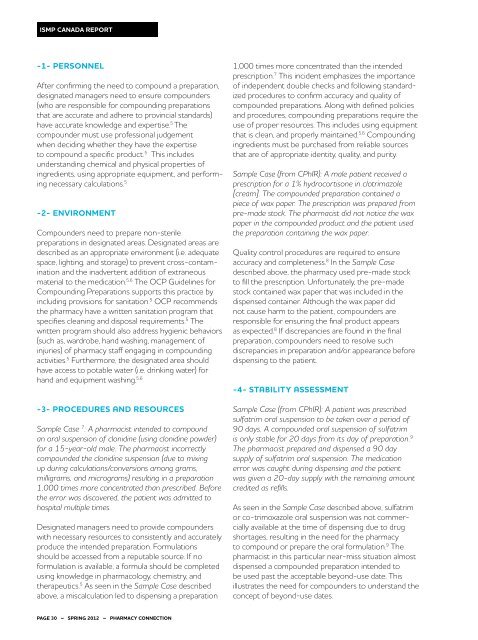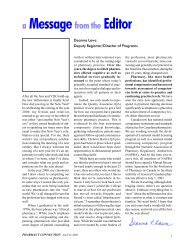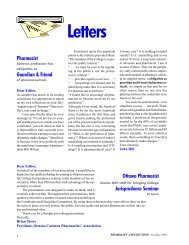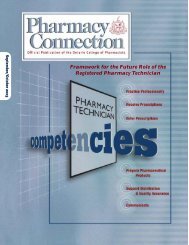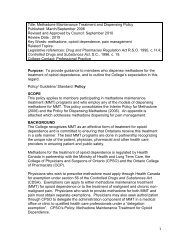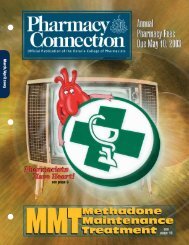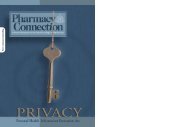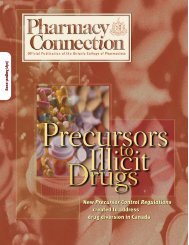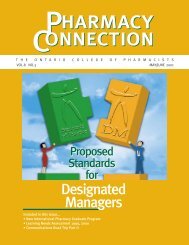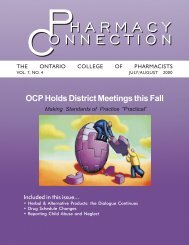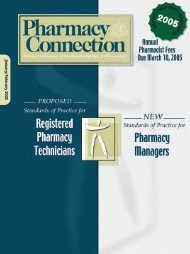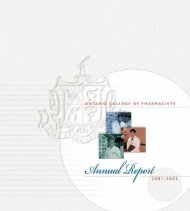Spring 2012 ⢠volume 19 number 2 - Ontario College of Pharmacists
Spring 2012 ⢠volume 19 number 2 - Ontario College of Pharmacists
Spring 2012 ⢠volume 19 number 2 - Ontario College of Pharmacists
Create successful ePaper yourself
Turn your PDF publications into a flip-book with our unique Google optimized e-Paper software.
ISMP CANADA report<br />
-1- Personnel<br />
After confirming the need to compound a preparation,<br />
designated managers need to ensure compounders<br />
(who are responsible for compounding preparations<br />
that are accurate and adhere to provincial standards)<br />
have accurate knowledge and expertise. 5 The<br />
compounder must use pr<strong>of</strong>essional judgement<br />
when deciding whether they have the expertise<br />
to compound a specific product. 5 This includes<br />
understanding chemical and physical properties <strong>of</strong><br />
ingredients, using appropriate equipment, and performing<br />
necessary calculations. 5<br />
-2- Environment<br />
Compounders need to prepare non-sterile<br />
preparations in designated areas. Designated areas are<br />
described as an appropriate environment (i.e. adequate<br />
space, lighting, and storage) to prevent cross-contamination<br />
and the inadvertent addition <strong>of</strong> extraneous<br />
material to the medication. 5,6 The OCP Guidelines for<br />
Compounding Preparations supports this practice by<br />
including provisions for sanitation. 5 OCP recommends<br />
the pharmacy have a written sanitation program that<br />
specifies cleaning and disposal requirements. 5 The<br />
written program should also address hygienic behaviors<br />
(such as, wardrobe, hand washing, management <strong>of</strong><br />
injuries) <strong>of</strong> pharmacy staff engaging in compounding<br />
activities. 5 Furthermore, the designated area should<br />
have access to potable water (i.e. drinking water) for<br />
hand and equipment washing. 5,6<br />
-3- Procedures and Resources<br />
Sample Case 7 : A pharmacist intended to compound<br />
an oral suspension <strong>of</strong> clonidine (using clonidine powder)<br />
for a 15-year-old male. The pharmacist incorrectly<br />
compounded the clonidine suspension (due to mixing<br />
up during calculations/conversions among grams,<br />
milligrams, and micrograms) resulting in a preparation<br />
1,000 times more concentrated than prescribed. Before<br />
the error was discovered, the patient was admitted to<br />
hospital multiple times.<br />
Designated managers need to provide compounders<br />
with necessary resources to consistently and accurately<br />
produce the intended preparation. Formulations<br />
should be accessed from a reputable source. If no<br />
formulation is available, a formula should be completed<br />
using knowledge in pharmacology, chemistry, and<br />
therapeutics. 5 As seen in the Sample Case described<br />
above, a miscalculation led to dispensing a preparation<br />
1,000 times more concentrated than the intended<br />
prescription. 7 This incident emphasizes the importance<br />
<strong>of</strong> independent double checks and following standardized<br />
procedures to confirm accuracy and quality <strong>of</strong><br />
compounded preparations. Along with defined policies<br />
and procedures, compounding preparations require the<br />
use <strong>of</strong> proper resources. This includes using equipment<br />
that is clean, and properly maintained. 5,6 Compounding<br />
ingredients must be purchased from reliable sources<br />
that are <strong>of</strong> appropriate identity, quality, and purity.<br />
Sample Case (from CPhIR): A male patient received a<br />
prescription for a 1% hydrocortisone in clotrimazole<br />
[cream]. The compounded preparation contained a<br />
piece <strong>of</strong> wax paper. The prescription was prepared from<br />
pre-made stock. The pharmacist did not notice the wax<br />
paper in the compounded product and the patient used<br />
the preparation containing the wax paper.<br />
Quality control procedures are required to ensure<br />
accuracy and completeness. 8 In the Sample Case<br />
described above, the pharmacy used pre-made stock<br />
to fill the prescription. Unfortunately, the pre-made<br />
stock contained wax paper that was included in the<br />
dispensed container. Although the wax paper did<br />
not cause harm to the patient, compounders are<br />
responsible for ensuring the final product appears<br />
as expected. 8 If discrepancies are found in the final<br />
preparation, compounders need to resolve such<br />
discrepancies in preparation and/or appearance before<br />
dispensing to the patient.<br />
-4- Stability Assessment<br />
Sample Case (from CPhIR): A patient was prescribed<br />
sulfatrim oral suspension to be taken over a period <strong>of</strong><br />
90 days. A compounded oral suspension <strong>of</strong> sulfatrim<br />
is only stable for 20 days from its day <strong>of</strong> preparation. 9<br />
The pharmacist prepared and dispensed a 90 day<br />
supply <strong>of</strong> sulfatrim oral suspension. The medication<br />
error was caught during dispensing and the patient<br />
was given a 20-day supply with the remaining amount<br />
credited as refills.<br />
As seen in the Sample Case described above, sulfatrim<br />
or co-trimoxazole oral suspension was not commercially<br />
available at the time <strong>of</strong> dispensing due to drug<br />
shortages, resulting in the need for the pharmacy<br />
to compound or prepare the oral formulation. 9 The<br />
pharmacist in this particular near-miss situation almost<br />
dispensed a compounded preparation intended to<br />
be used past the acceptable beyond-use date. This<br />
illustrates the need for compounders to understand the<br />
concept <strong>of</strong> beyond-use dates.<br />
PAGE 30 ~ SPRING <strong>2012</strong> ~ PHARMACY CONNECTION


